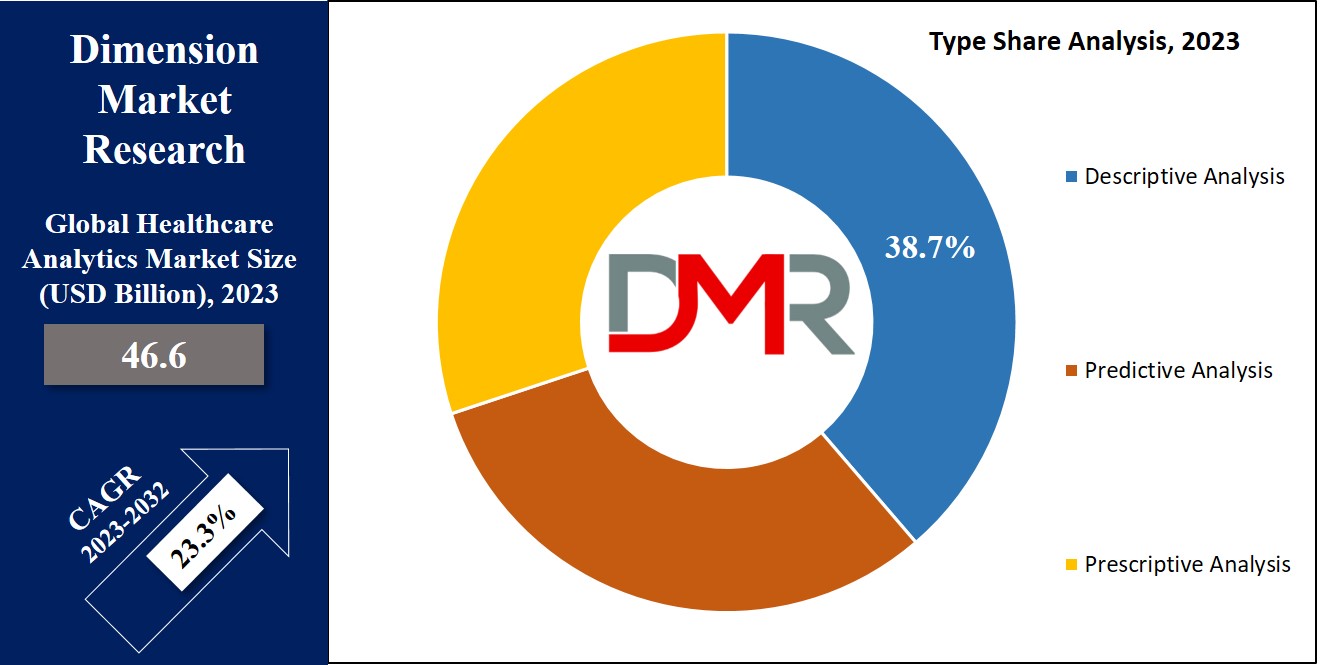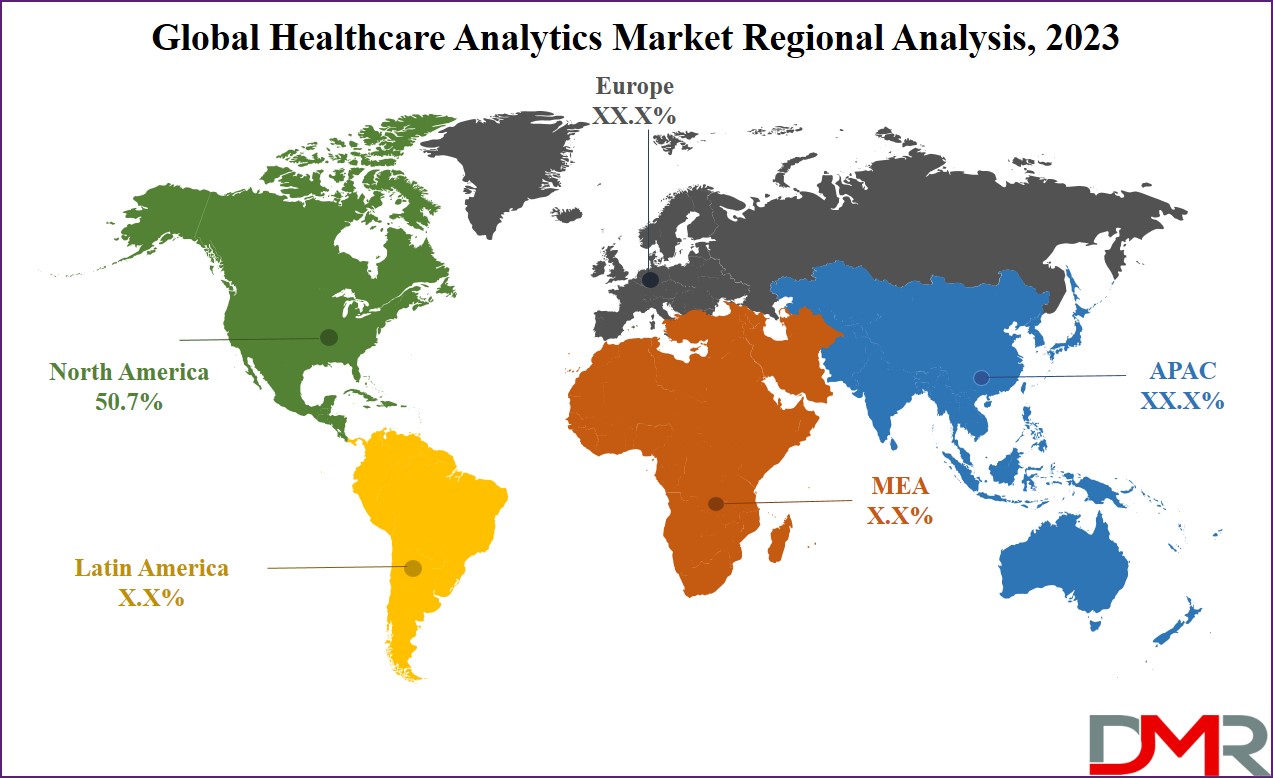Market Overview
The Global Healthcare Analytics Market is expected to reach a value of
USD 46.6 billion in 2023, and it is further anticipated to reach a market value of
USD 307.7 billion by 2032 at a
CAGR of 23.3%.
The Global Healthcare Analytics Market refers to the comprehensive market ecosystem that is engaged in the utilization and production of analytical tools, technologies, and solutions within the healthcare industry. This market revolves around the analysis and interpretation of vast volumes of
healthcare data to derive meaningful insights to enhance the decision-making processes and optimize operational efficiency that will ultimately improve patient outcomes.
Healthcare analytics allows healthcare professionals to improve the various facilities in their respective sectors. In healthcare analytics, it merges historical data & real-time data to predict future trends that will significantly improve
medical care and fuel long-term growth. Furthermore, this system uses a large amount of data to analyze which makes it more reliable as it improves its accuracy and precision.
Market Dynamic
The rapid pace of technological progress and substantial investments by the healthcare sector in technological development and digitization have been playing a vital role in the expansion of the global healthcare analytics market. Major analytical platforms which are currently employed in the healthcare sector are significantly contributing to enhancing patient management and retention.
The implementation of healthcare analytical platforms not only boosts the productivity of staff but also enhances overall patient management, which extensively reduces the workload on healthcare professionals.
Healthcare analytics can be used in different ways for various functions in the healthcare sector, such as making appointments, patient records, insurance claims, donations etc.
It can not only improve the quality of care delivered to patients but also give insights for managing overall business establishments, better patient outreach and managing the spread of diseases. Analytical platforms are not only being used by hospitals but are also used by other establishments for managing and interpreting clinical data from various research papers, studying historical data and analyzing it to establish trends, and developing methods, tools and technologies to get optimal results.
Research Scope and Analysis
By Type
Descriptive analysis plays a crucial role in healthcare analytics where it provides valuable insights into historical data to comprehend and summarize past trends to gain a comprehensive understanding of past events, patient outcomes, and operational patterns. Therefore, the description analysis dominates this segment based on type, as it holds 38.7% of the market share in 2023 and is expected to show significant growth in the forthcoming period of 2023 to 2032.

Descriptive analysis is extensively used in the healthcare sector as healthcare providers use it to examine patient demographics and trends over time. It also includes the analysis of patient characteristics, such as age, gender, and geographic location, that helps healthcare professionals and organizations to tailor healthcare services for specific population segments. Furthermore, descriptive analysis in the global healthcare analytics market plays a crucial role in assessing disease prevalence and epidemiological patterns.
By Delivery Mode
Based on delivery mode in healthcare analytics, on-premise solutions hold a significant portion of this market as they bring distinctive advantages to organizations. On-premise solutions offer direct control over the data to healthcare organizations. This localized control over data ensures that sensitive patient information and critical healthcare data are managed within the organization's physical infrastructure as it promotes data security and compliance.
Healthcare analytics solutions also offer a high level of customization as these organizations require a tailored analytical platform to meet specific requirements of the existing on-site systems, ensuring a more flexible and personalized approach.
Moreover, on-premise analytics solutions often provide fast processing speed that directly influences the performance which is beneficial in healthcare scenarios where real-time analytics and quick decision-making are crucial for patient care, diagnosis, and treatment.
By Application
Based on application, financial data analytics holds the highest market share of 44.9% in this segment in 2023 and is expected to register significant growth in the forthcoming period of 2023 to 2032.
Their dominance can be attributed to healthcare organizations that use financial data analytics to optimize the cost of various products by analyzing financial data.
It is also used by companies where they use financial data analytics to identify inefficiencies, reduce unnecessary expenditures, and enhance their overall financial performance. Major healthcare providers around the world use financial data analytics to streamline and improve their revenue management by using it to optimize the billing processes, reduce claim denials, and ensure timely reimbursement.
By End-User
In this segment, life science companies show dominance as they hold a substantial portion of this market in 2023 and are expected to show subsequent growth in the upcoming years as well.
In this segment Life science companies dominate this segment as they majorly rely on data analytics to organize their research and development processes. These advanced analytics tools help life science companies in the identification of potential drug candidates by optimizing clinical trial designs and predicting the experiment outcomes.
Analytics are extensively used in this field as they assist life science companies in designing clinical trials that are more efficient and cost-effective. In healthcare analytics it consists of all the historical trial data, identifying patient cohorts, and predicting trial success factors, analytics contributes to the overall optimization of the clinical trial process.
Moreover, healthcare analytics are also crucial in monitoring and ensuring drug safety. Life science companies use analytics to analyze the side effects, detect patterns, and proactively address the safety concerns of clinical trials. This proactive approach enhances patient safety and regulatory compliance.
The Healthcare Analytics Market Report is segmented on the basis of the following:
By Type
- Descriptive Analysis
- Predictive Analysis
- Prescriptive Analysis
By Delivery Mode
- On-premise
- Web-hosted
- Cloud-based
By Application
- Financial Data Analytics
- Clinical Data Analytics
- Administrative Data Analytics
By End-User
- Life Science Companies
- Healthcare Payers
- Healthcare Provider
Regional Analysis
North America leads the healthcare analytics market with the largest revenue share at 50.7% in 2023, which can be attributed to many key factors, like the region being a hub for major technology giants, and innovative startups. This region also consists of advanced healthcare facilities and robust technological infrastructure that are driving the development of healthcare analytics.

Also, Microsoft one of the biggest technological giants, introduced Microsoft Cloud for Healthcare which fosters the relationship between patients and healthcare providers to enhance user insights. In addition, this region experiences a high demand for analytics tools driven by the rise in chronic diseases & a growing elderly population.
These factors collectively contribute to the growth of this market in North America as it creates a heightened need for analytics tools and the availability of cutting-edge technology in this region supports the efficient deployment and utilization of analytics solutions across the healthcare sector.
By Region
North America
Europe
- Germany
- The U.K.
- France
- Italy
- Russia
- Spain
- Benelux
- Nordic
- Rest of Europe
Asia-Pacific
- China
- Japan
- South Korea
- India
- ANZ
- ASEAN
- Rest of Asia-Pacific
Latin America
- Brazil
- Mexico
- Argentina
- Colombia
- Rest of Latin America
Middle East & Africa
- Saudi Arabia
- UAE
- South Africa
- Israel
- Egypt
- Rest of MEA
Competitive Landscape
The global healthcare analytics market has experienced notable shifts catalyzed by the COVID-19 pandemic. The leading key entities in the global healthcare analytics industry are extensively involved in innovating and introducing advanced technologies to improve the interpretation of data derived from patients to gain insights into the transmission and containment of diseases.
This drive aims to provide enhanced care solutions for healthcare providers and institutions. The integration of big data analytics and
artificial intelligence has led to the creation of novel platforms for more effective data understanding and analysis. Swedish Health Services, a healthcare organization based in the United States, exemplifies this trend by developing a platform enabling healthcare workers to report real-time COVID-19 patient data and other metrics, thereby monitoring facility statuses across hospitals.
Prominent figures in the global healthcare analytics sector continuously pioneer and enhance analytical solutions while expanding their product portfolios. To assist healthcare organizations in implementing data analysis solutions, addressing pandemic challenges, and maintaining a competitive edge in the healthcare analytics domain, companies prioritize strategic alliances, technological collaborations, and product launches.
Some of the prominent players in the Global Healthcare Analytics Market:
- McKesson Corporation
- Optum Inc.
- IBM
- Oracle
- SAS Institute Inc.
- IQVIA
- Verisk Analytics Inc.
- Elsevier
- Medeanalytics Inc.
- Truven Health Analytics Inc.
- Allscripts Healthcare Solutions Inc.
- Cerner Corporation
- Other Key Players
COVID-19 Pandemic & Recession: Impact on the Global Healthcare Analytics Market:
The COVID-19 pandemic and the following economic recession have left a significant impact on various industries, including the healthcare analytics market. The pandemic emphasized the importance of data-driven decision-making in healthcare which is why healthcare providers sought out robust analytics solutions to track and analyze COVID-19 trends, to efficiently allocate vital resources to patients who tested positive for the COVID-19 virus.
Due to lockdown and social distancing measures to minimize the transmission of COVID-19, telehealth saw a surge in demand, leading to a greater demand for analytics tools to manage and analyze remote patient data. Remote patient monitoring became crucial during this phase, driving the need for analytics to derive insights from the collected data.
Moreover, the COVID-19 pandemic also highlighted the importance of predictive analytics in forecasting the healthcare needs of patients therefore, now healthcare organizations are more inclined to invest in predictive analytics to prepare a better future plan to tackle healthcare crises.
Report Details
| Report Characteristics |
| Market Size (2023) |
USD 46.6 Bn |
| Forecast Value (2032) |
USD 307.7 Bn |
| CAGR (2023-2032) |
23.3% |
| Historical Data |
2017 - 2022 |
| Forecast Data |
2023 - 2032 |
| Base Year |
2022 |
| Estimate Year |
2023 |
| Report Coverage |
Market Revenue Estimation, Market Dynamics, Competitive Landscape, Growth Factors and etc. |
| Segments Covered |
By Type (Descriptive Analysis, Predictive Analysis and
Prescriptive Analysis), By Delivery Mode (On-premise,
Web-hosted and Cloud-based), By Application
(Financial Data Analytics, Clinical Data Analytics and
Administrative Data Analytics), By End-User (Life
Science Companies, Healthcare Payers and
Healthcare Provider) |
| Regional Coverage |
North America – The US and Canada; Europe – Germany, The UK, France, Russia, Spain, Italy, Benelux, Nordic, & Rest of Europe; Asia- Pacific– China, Japan, South Korea, India, ANZ, ASEAN, Rest of APAC; Latin America – Brazil, Mexico, Argentina, Colombia, Rest of Latin America; Middle East & Africa – Saudi Arabia, UAE, South Africa, Turkey, Egypt, Israel, & Rest of MEA
|
| Prominent Players |
McKesson Corporation, Optum Inc., IBM, Oracle, SAS
Institute Inc., IQVIA, Verisk Analytics Inc., Elsevier,
Medeanalytics Inc., Truven Health Analytics Inc.,
Allscripts Healthcare Solutions Inc., Cerner
Corporation, and Other Key Players |
| Purchase Options |
We have three licenses to opt for: Single User License (Limited to 1 user), Multi-User License (Up to 5 Users), and Corporate Use License (Unlimited User) along with free report customization equivalent to 0 analyst working days, 3 analysts working days and 5 analysts working days respectively. |
Frequently Asked Questions
The Global Healthcare Analytics Market size is estimated to have a value of USD 46.6 billion in 2023 and
is expected to reach USD 307.7 billion by the end of 2032.
North America has the largest market share for the Global Healthcare Analytics Market with a share of
about 50.7% in 2023.
Some of the major key players in the Global Healthcare Analytics Market are McKesson Corporation,
Optum Inc., IBM, Oracle, SAS Institute Inc., IQVIA, Verisk Analytics Inc., Elsevier, Medeanalytics Inc.,
Truven Health Analytics Inc., Allscripts Healthcare Solutions Inc., Cerner Corporation and many others.
The market is growing at a CAGR of 23.3 percent over the forecasted period.